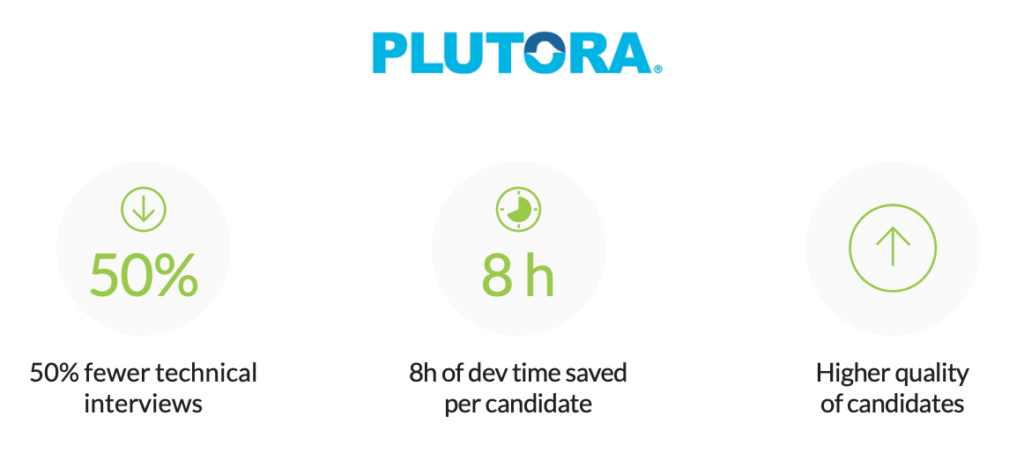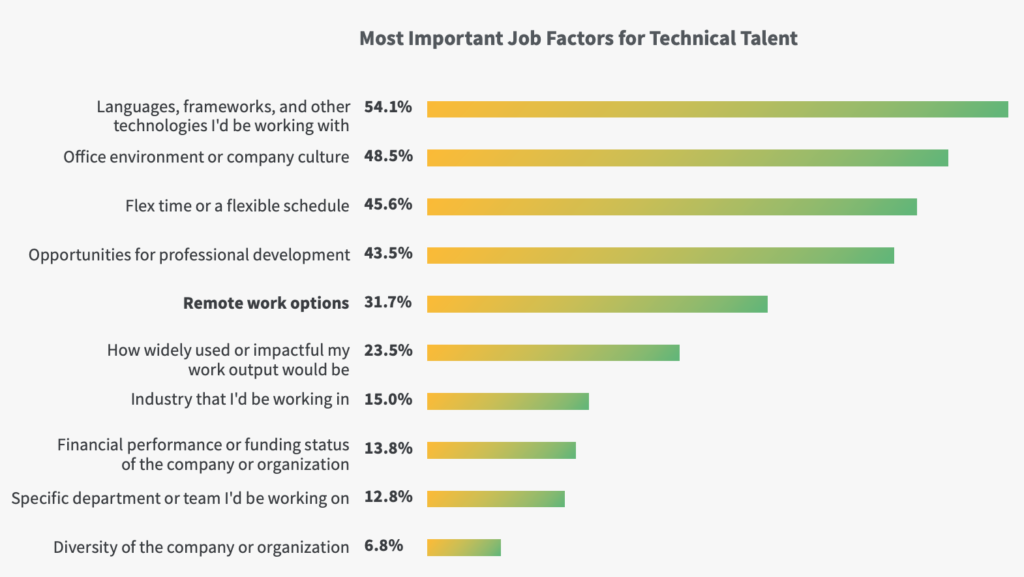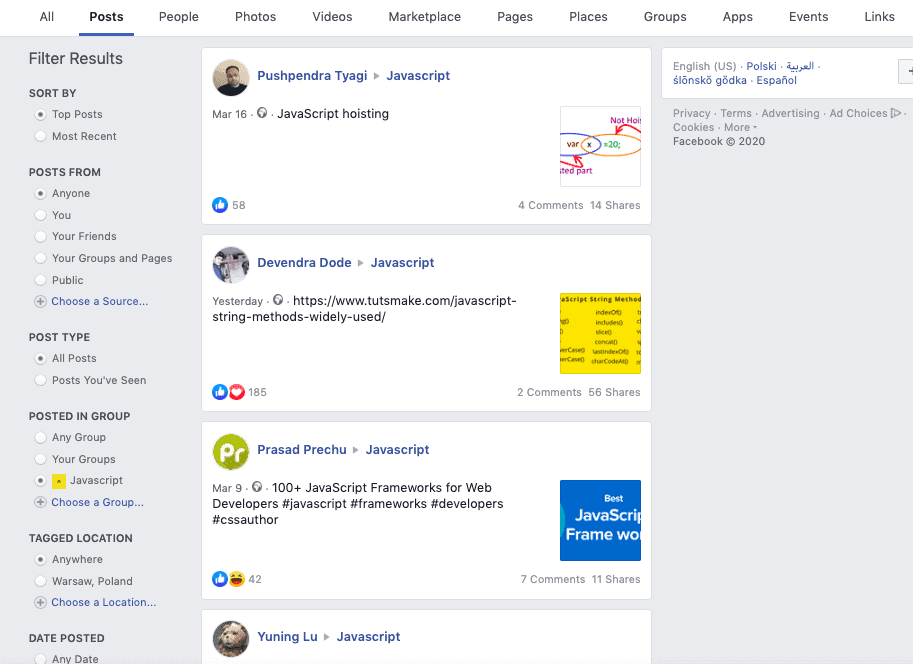How to hire remote developers – a step by step remote hiring guide

The working world has completely shifted since the outbreak of COVID-19. In fact, approximately 74% of professionals expect remote work to become the standard for years to come. It’s now more clear than ever that this is not only a remote hiring trend; it’s the future of work.
In the following article, we’ll walk you through the ins and outs of remote hiring – from sourcing and screening candidates to online interviews and effective onboarding.
Let’s jump right in.
The pros and cons of hiring remote employees in tech
Let’s take a look at some of the most important benefits of hiring remotely.
Pros of becoming a remote recruiter
#1 Access to better tech talent
Let’s be honest – who wouldn’t want a chance at reaching more suitable candidates? Your ideal candidate might not be living anywhere near your office – which is no reason to not consider them for your business.
#2 Saving time on skills assessments
While more candidates will be potentially applying if you become remote-friendly, it doesn’t mean your recruitment capacity will suddenly be strained. Quite the contrary; there are plenty of remote skills assessment methods – some, like DevSkiller’s coding tests, are fully automated. Such solutions also let you eliminate any underperforming candidates early on from the recruitment process. As an example, our client Plutora saves approximately 8 hours of developer time per every candidate.

Check out the success stories of our customers here.
You can also test your candidates’ skills live, without the need of being in the same room (or, at least, a physical one). With the right tool, you can conduct pair programming with your candidates online. We discuss this further in this post.
#3 No recruitment travel costs (or relocation packages)
In the olden days, if you found a suiting candidate who lived far from your office, you’d pay for the expenses of bringing them in for an interview. If the candidate knocked you off your feet and you were ready to extend them an offer, you’d have to negotiate if they were open to relocation. It would also be customary to take care of the relocation costs and/or paperwork– another expense for your business.
On the other hand, if you embrace a remote hiring process, you’ll be saving a lot of money (not to mention, your candidates’ time).
#4 Lower office costs
You won’t need to worry about your office becoming too small if you grow. In fact, if you decide to go fully remote, like many global tech players (including Buffer and Zapier), you won’t have to worry about an office at all!
According to PGi, the average real estate savings with full-time teleworkers is $10,000 per employee per year. The insurance giant Aetna shed 2.7 million square feet of office space resulting in a cost saving of $78 million per year.
Worth looking into, isn’t it?
#5 Higher employee satisfaction
According to Stack Overflow research, remote work is one of the top priorities for software developers.

Buffer also reports that 99% of employees who’ve previously worked remotely would want to retain at least a partial remote-work arrangement for the remainder of their careers. This is an important factor, which can lead to lower employee attrition.
What’s more, according to OwlLabs research:
“Remote workers say they are likely to stay in their current job for the next 5 years 13% more than onsite workers”.
#6 Higher productivity levels
Provided that you introduce the right processes, giving your employees the liberty to work from wherever they wish also translates to higher productivity levels.
“FlexJobs’ annual survey found that 65% of respondents are more productive in their home office than at a traditional workplace”.
#7 Better employee branding
If you make a name for yourself as a remote employer, you might land yourself a spot in a “top remote hiring employers in tech” article (something for the likes of this piece on the Zapier blog). Happy employees will also be a source of good PR online in tech forums or social media groups.
What about the potential cons of remote hiring? Let’s have a look.
Potential cons (and ways of preventing them from happening)
#1 Lack of company culture
You might worry you’ll be unable to create and nurture a strong company culture. This means anything from employees not knowing what values the company stands for, to not feeling like part of a bigger team due to distance and anonymity.
However, it doesn’t have to be the case!
Software development company Clevertech offers its employees ways to interact online regularly (for instance, book clubs). They run an internal newsletter and send out company swag boxes. Employees are also encouraged to share on social media the fun they’re having – both during or after work.
#2 Security
You don’t have control over your employees’ WiFi, or whether they’re working from a cafe that has poor Internet security.
Here are a couple of crucial security tips:
- make sure to protect devices with an antivirus solution
- ensure that all employees install system updates
- use password encryption apps and corporate cloud solutions
- educate your employees to lock their computers when away from their devices
#3 Hiring employees who can’t work well remotely
Let’s be completely honest – remote work won’t be a good option for every single employee – just like not every on-site hire will turn out to be a good fit. Some employees might either abuse the lack of physical supervision, or simply struggle to be productive without an office environment.
The good news is, there’s a lot you can do to avoid this.
Employees who are new to remote work might need your guidance at first if they struggle with the new environment.
To minimize the risk of hiring employees who will use remote work conditions to consciously underperform, a thorough soft skills and culture fit interview will be crucial. At the same time, some employees may underperform despite their best intentions. Offer support and review their projects and processes to help them figure out a way to make things work.
What does the process of hiring remote developers look like? A step-by-step guide
Now that we’ve covered the pros and cons, let’s see how to hire remote workers!
Step 1: Sourcing
There are two key ways in which you can source tech talent.
Post a job ad
In order to reach as many talented IT candidates as possible, post a job offer on popular tech job boards. Among others, we recommend that you post your ad on CrunchBoard, AngelList, and Stack Overflow. Make sure to underline that you’re a remote employer.
Also, post your offer on special remote work boards like We Work Remotely or RemoteOK.
Look for talent online
We recommend that you also search for candidates actively. You can find them not just on LinkedIn or Stack Overflow, but also on Facebook, Reddit, Twitter, and Instagram. We’ve written a separate piece on social recruiting that explains this method in detail.

Step 2: Screening
Once you’ve found an interesting candidate, it’s time to evaluate their skills remotely.
Look at their Stack Overflow and GitHub accounts
Make sure to check:
– Stack Overflow: the number of responses to questions. How active and helpful are they to the community? This will tell you not just whether they know about a subject; it will also reveal if they have a team spirit.
– GitHub: how many and what kind of projects they’ve contributed to. Check the number of repositories and contributions. When did they join GitHub, and how many followers do they have?
Evaluate their skills with a DevSkiller work sample coding test
Invite the candidate to take a remote work sample coding test.
Here’s how they work:
Work sample coding tests let you simulate a day in the life of a software developer at your company, by giving candidates a practical assignment. They are provided access to the same type of environment your developers normally use – libraries, frameworks, GitHub, or Stack Overflow (…) During a work sample test, candidates are given a time limit that reflects how long you’d normally expect your developer to deliver a similar solution.
https://devskiller.com/how-to-assess-programming-skills/
Unlike regular algorithmic or whiteboard tests, work sample coding tests provide your candidates with context – not just questions that test their theoretical knowledge of a language.
Here are some other benefits of work sample tests:
- They’re objective (no personal bias is involved – unlike in many traditional interviews)
- They’re automated (HR can conduct them without the engagement of the CTO or hiring manager)
- They will let you filter out and interview only the best candidates (for instance, Atlassian Marketplace vendor Spartez reduced their interview load 8.6x after they started using DevSkiller coding tests).
Step 3: Interview
After conducting thorough screening, you should have a good overview of whom to invite to an interview.
There are two types of remote interviews you should run.
Soft skills evaluation interview
The goal of a soft skills evaluation interview is to check whether your candidate fits your company culture. Do they seem like someone who shares your values and would find their way around with your current team?
As there are no technical questions involved in this stage, it can be conducted by HR only.
If you’re looking for inspiration on what to ask your candidate, here’s a great resource with 45 behavioral questions.
Technical interview
If all goes well during the soft skills interview, your CTO or hiring manager should schedule an online technical interview.
It should focus on two areas – reviewing one’s experiences and checking their skills during a tech interview, which sometimes is carried out in a pair programming session.
During the technical interview, the hiring manager should discuss the candidate’s previous projects – what their role was, which tasks they tackled, how, and why.
Next, it’s time to proceed to the live coding session, which is sometimes part of the process.
Pair programming
During a pair programming session, the interviewer gets to work on a test project together with the candidate. With DevSkiller, this can all be done online.
The interviewer has full, real-time access to the same IDE that the candidate has, and can work on the project together with them (for example, by deleting or adding code).

What makes pair programming an essential recruitment step is that it lets you check not just how the candidate writes their code, but also how they think and solve any problems. During the session, you can also note what questions the candidate asks about the project goals.
If your tech team is satisfied with the outcome of the remote pair programming session, chances are your candidate will be a great fit, and you can now prepare an offer.
Step 4: Offer
Once you’ve found the ideal candidate, it’s time to extend an offer. Depending on your preferences, you can propose a standard trial period (for example, 3-months long) or a paid work trial. The latter option will let you verify if both sides feel comfortable working with each other remotely.
It’s also important that your legal team prepares the right contract type. This is crucial especially if you’re hiring someone from abroad, as you need to establish which party will be responsible for tax deductibles or healthcare.
Step 5: Day 1 and beyond…
By the time your employee comes aboard, you’ll need to have a comprehensive plan in place on how you’ll be cooperating together. Things like time zone overlap or your approach towards time tracking tasks matter immensely!
As far as onboarding is concerned, you should:
- create a checklist of the things your new employee needs to learn about your company and their new role,
- designate an onboarding buddy to answer all their questions. It’s super important to have someone there for your new hires – especially in a remote setting.
Summary
As an IT employer, there are plenty of reasons why you should shift to remote hiring. Access to better tech talent, recruitment savings, and higher employee satisfaction levels are just some of the perks of being a remote-friendly company.
Luckily, even if you’ve never employed a single off-site employee before, there are methods and tools that allow you to recruit new hires 100% online!
Use DevSkiller’s coding tests to filter out the very best talent, and conduct pair programming to test your candidates – just as you would in a real-life setting.
All that’s left to say? Good luck with your remote hiring endeavors!
Image credit: Unsplash
Share post